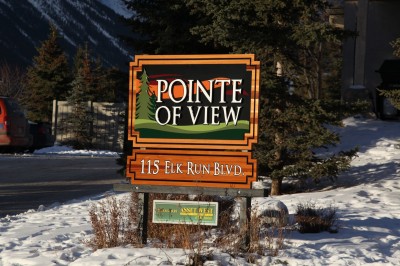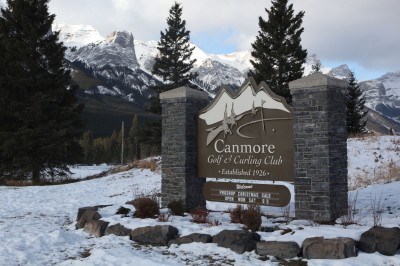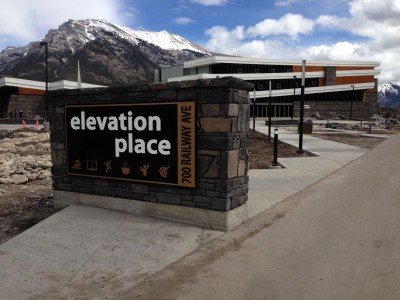 Made for Canmore
Made for Canmore
CanSign handles sign projects from start to finish, offering design services, permit applications, engineering and construction drawings, fabrication, installation, maintenance, restoration and even neon tube repairs.
Permit applications are a particularly important process in both Canmore and nearby Banff, where bylaws intended to preserve the towns’ beauty and reduce ‘visual pollution’ significantly restrict the types of signs that can be displayed outdoors.
“Way back in the day, Canmore didn’t set many limitations,” says Halprin. “A building would simply have space allotted for a sign. Once the town started to write bylaws, Dad made sure to get involved, so the process would help everyone.”
The resulting local regulations for signs in Canmore have set square footage limits and clearances from grade to base. Light and white backgrounds are frowned upon.
“They won’t allow ‘big city’ signs,” Halprin explains. “There are no halo-lit or backlit signs, unless they were grandfathered in from years ago. Our clients may have to pay a premium to comply with the bylaws, but at least it’s easier here than in Banff, where the rules are a little more stringent and the signs are a lot more expensive. In Canmore, for example, we can use leftover bits of wood from the mill, but in Banff, all of the signs have to be made of Western red cedar.”
To stay within Canmore’s regulations while the sign industry continues to evolve, CanSign focuses much of its efforts on testing new materials as they emerge in the market. This is also important when considering the local climate.
“Materials come and go, but their manufacturers often test them in warmer, humid climates compared to here,” says Halprin. “So, we go through a lot of trial and error before we will convince our customers to use these materials.”
 One of CanSign’s newest projects is Elevation Place, a 7,154-m2 (77,000-sf) multi-use community facility in Canmore, primarily funded through the provincial government’s Municipal Sustainability Initiative (MSI). Set to open this year, it houses a library, aquatics centre, art gallery, climbing centre and multi-purpose rooms. CanSign was hired to design the facility’s sign system.
One of CanSign’s newest projects is Elevation Place, a 7,154-m2 (77,000-sf) multi-use community facility in Canmore, primarily funded through the provincial government’s Municipal Sustainability Initiative (MSI). Set to open this year, it houses a library, aquatics centre, art gallery, climbing centre and multi-purpose rooms. CanSign was hired to design the facility’s sign system.
“We bid against several other companies for this project,” says Halprin. “Most of them are design firms that specified polymethyl methacrylate (PMMA) signs, but we did a lot of extra legwork to find materials that would help the building earn Leadership in Energy and Environmental Design (LEED) points. We’re working with bamboo-based plywood and low-VOC clearcoats. In addition to the environmental benefits, these help make the signs lighter.”
When complete, Elevation Place will feature more than 300 signs, including cut-out bamboo plywood letters, decals and aluminum signs.
A full workload
Although most of its projects are nowhere near as big as Elevation Place, CanSign’s workload has remained steady throughout Canmore’s economic ups and downs over the years.
“Businesses turn over quickly here, which is difficult for them, but good for us, since new businesses mean new signs are needed,” says Halprin. “We also ship signs nationally—including reflective aluminum signs for Parks Canada campgrounds—and sometimes internationally.”
 Overall, Halprin estimates 60 per cent of the company’s output is for the local market (including both Canmore and Banff), 20 per cent is for other Canadian businesses and the remaining 20 per cent is split between government and international clients.
Overall, Halprin estimates 60 per cent of the company’s output is for the local market (including both Canmore and Banff), 20 per cent is for other Canadian businesses and the remaining 20 per cent is split between government and international clients.
“I have a friend in Alaska who has us ship truck decals to Idaho for him,” he says. “It’s all about your contacts. We have a lot of quotes out now and our work order board is full. It’s an endless supply.”
The company has struggled somewhat to meet that level of demand, however, because staffing has proven to be a big challenge in a small town.
“I would like to have about three more employees working in twice as much space, but it’s hard to find suitable staff,” Halprin says. “A lot of people want to work here, but some have no experience and some can only commit to a short-term position. We’ve even had people afraid of heights apply to be sign installers!”
That said, Halprin is happy with the current team.
“We have brought on a new office administrator and designer,” he says. “One young fellow, Stephen Raso, has been with us for nine years. He went through the Northern Alberta Institute of Technology’s (NAIT’s) Graphic Sign Arts Program and graduated first in his class with honours in 2010. The next step is for him to become a 3M-preferred installer, too!”





